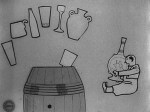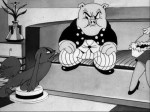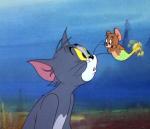You are currently browsing the tag archive for the ‘dream’ tag.
Director: Andrei Khrzhanovsky
Release date: 1973
Rating: ★★★
Review:
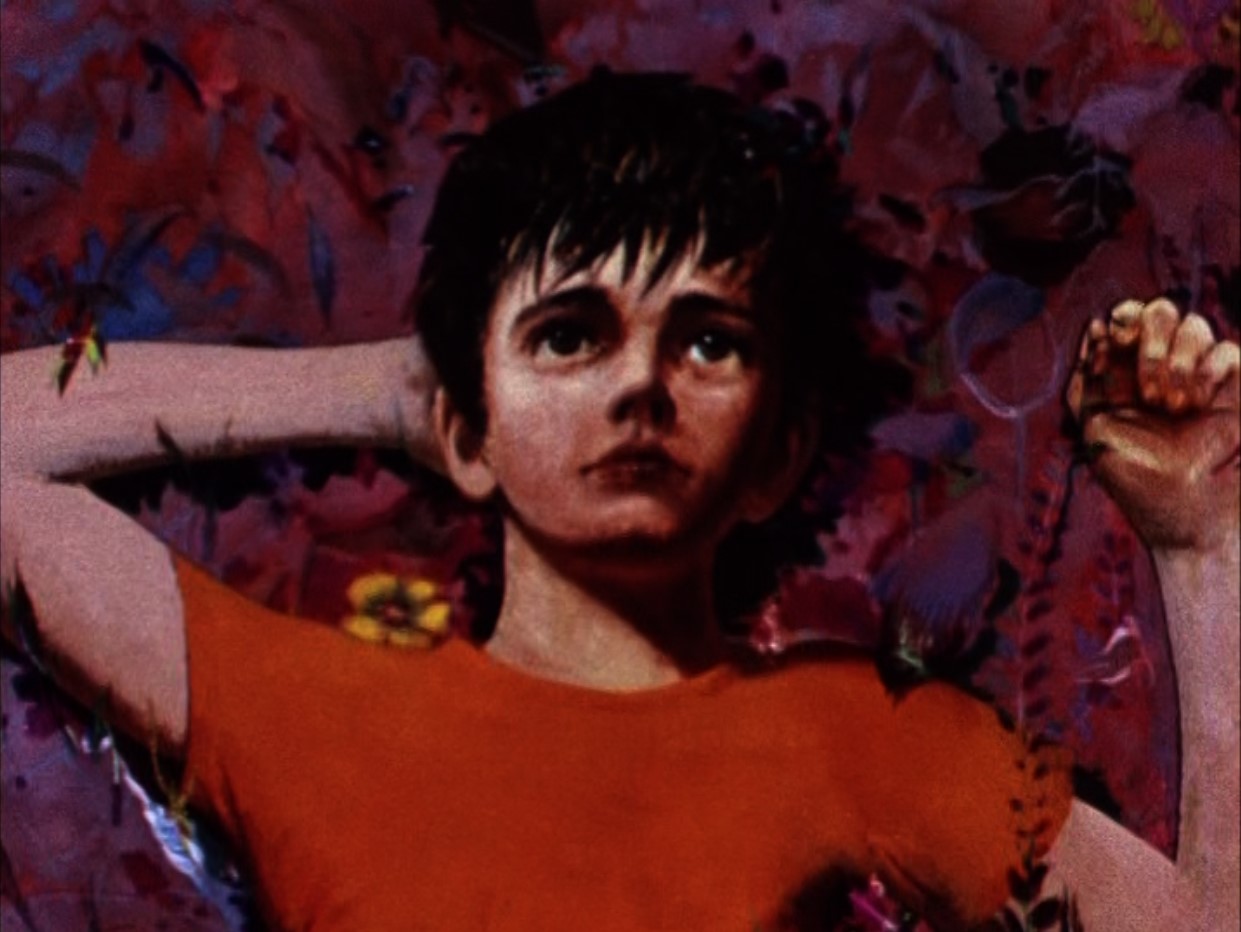
In ‘Butterfly’ a boy catches some butterflies, but after a nightmarish scene in which he himself is trapped, he releases them again.
The plot of ‘Butterfly’ is far from original, and rather predictive and boring, but Khrzhanovsky’s eclectic style is not. Part of the story is told in still oil paintings, but there’s also a little cell animation and cut-out animation.
The oil paintings are most interesting, with their rather high level of realism, and their painful contrast between colorful nature, and the dull, grey world of the modern city. Especially the scene inside the boy’s flat is most depressing, with only grey electronic robots to play with. Nevertheless, the most striking aspect of this film are not the animation nor the visuals, but the fascinating score by avant-garde composer Alfred Schnittke.
Watch ‘Butterfly’ yourself and tell me what you think:
‘Butterfly’ is available on the DVD ‘Masters of Russian Animation Volume 2’
Director: Howard S. Moss
Release Date: 1917
Rating: ★
Review

‘Dolly Doings’ is an entry in the ‘Motoy Comedies’ series, which was apparently based on the book series ‘Motoys in Life’.
The short mixes live action and stop motion to tell the story of a little girl who dreams that her dolls come to life. One particularly mischievous doll called Jimmy taunts the others with a needle.
The dolls lack any character and are very poorly animated, not exceeding the amateur level. The action is hard to comprehend, and the ‘story’ too trite to be of any interest. The intertitles, too, are painfully unfunny. I’ve no idea how many Motoy Comedies have been made, but based on the judgement of this entry this series can’t hardly have been successful.
Dolly Doings’ is available on the Thunderbean Blu-Ray/DVD-combo ‘Techicolor Dreams an Black & White Nightmares’
Director: Petra Freeman
Release Date: 1994
Rating: ★★½
Review:

‘Jumping Joan’ is a dreamlike short about a girl who seems able to jump inside and outside reality.
The narrative is set around a house in the countryside, next to a forest and a river. Petra Freedman’s images are poetic and intriguing, but also very vague and incomprehensible. If there’s a story to this film I couldn’t detect it. What remains are the soft painted images of the girl moving through a garden and other-wordly places, meeting spirits of the earth, the wood and the sky, or so it seems.
The film turns particularly puzzling when the little girl drops two bunny-like creatures from under her skirt, which dance with a blue spirit, living inside a hollow tree, while the girl seems to change into some electrical firework(?) What this all might mean, remains an utter mystery to me.
Petra Freeman’s drawing style is soft, and a little spiritual. Her animation style is a bit slow, but very imaginative, and she uses a fair amount of metamorphosis to tell her story. The film is dominated by earthly reds and blacks, and the dreamlike atmosphere is greatly enhanced by the sound design, which uses strange sounds, and very little music.
Watch ‘Jumping Joan’ yourself and tell me what you think:
‘Jumping Joan’ is available on the DVD ‘The Best of British Animation Awards 1’
Directors: Herbert M. Dawley & Willis O’Brien
Release Date: November 17, 1918
Rating: ★★★
 This film was produced, acted and animated by Herbert M. Dawley and Willis O’Brien.
This film was produced, acted and animated by Herbert M. Dawley and Willis O’Brien.
Dawley plays ‘Uncle Jack Holmes’, who tells two boys a story about how he camped out on slumber mountain and meets the ghost of Mad Dick there (played by O’Brien). The ghost tells Holmes to watch through a magic instrument, and the uncle suddenly sees prehistoric animals in the distance.
At this point the film is nine minutes away, and by O’Brien’s skillful animation we watch a Brontosaurus wandering, a Diatryma (a giant flightless bird, now Gastornis) catching a snake, two Triceratopses fighting, and a Tyrannosaurus killing one of the Triceratopses.
Especially the animation on the first Triceratops is well done, O’Brien even shows the creature breathing. Another nice detail is that of the Tyrannosaurus licking its lips. Most importantly, O’Brien doesn’t show the prehistoric creatures not as monsters but as convincingly living creatures. No wonder this master animation was asked to do the dinosaur animation for ‘The Lost World’ (1925), and for all kinds of creatures in ‘King Kong‘ (1933).
It’s a pity the film is rather lackluster (in the end it all appears to be a dream, and even the boys don’t really buy that trite ending), for the animation is certainly worth watching once.
Watch ‘The Ghost of Slumber Mountain’ yourself and tell me what you think:
‘The Ghost of Slumber Mountain’ is available on the Blu-Ray of ‘The Lost World’
Director: Émile Cohl
Release Date: 1916
Rating: ★★★
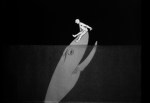 ‘Les exploits de Farfadet’ is a very short cut-out animation film, not even clocking two minutes.
‘Les exploits de Farfadet’ is a very short cut-out animation film, not even clocking two minutes.
In this short a man dreams he loses his hat at sea, drowns and gets swallowed by a huge fish.
The atmosphere of this film is very surreal and, indeed, dream-like, with a clear feel of unreality, and an illogical flow of events. The man speaks in text balloons , and in the end he blames his bad dream on rum, very much like Winsor McCay’s rarebit fiends.
Watch ‘Les exploits de Farfadet’ yourself and tell me what you think:
‘Les exploits de Farfadet’ is available on the DVD-set ‘Émile Cohl – L’agitateur aux mille images’
Director: J.R. Bray
Release Date: June 12, 1913
Stars: J.R. Bray
Rating: ★★★★
 J.R. Bray is the father of the cartoon industry, but this short is from a period in which J.R. Bray was still a lone artist, like other animation pioneers as J. Stuart Blackton, Émile Cohl and Winsor McCay.
J.R. Bray is the father of the cartoon industry, but this short is from a period in which J.R. Bray was still a lone artist, like other animation pioneers as J. Stuart Blackton, Émile Cohl and Winsor McCay.
In fact, ‘The Artist’s Dream’ is only J.R. Bray’s second attempt at animation, and the film is still rooted in the drawings come to life tradition of the earliest animated films.
Bray plays an artist drawing a dachshund and a sausage. While he’s away the dachshund eats the sausage, and later another till he explodes. Of course, all has been a dream, which clearly shows the strong influence of Winsor McCay’s dreams of the rarebit fiend.
‘The Artist’s Dream’ shows Bray’s extraordinary drawing skills, as his drawings are very clear and contain elegant shading. His handling of perspective is perfect and no less than McCay’s. The animation, on the other hand, is less fluent than McCay’s, if still of a remarkably high quality. Unfortunately, he would not transfer this level of art to his later studio films.
Watch ‘The Artist’s Dream’ yourself and tell me what you think:
‘The Artist’s Dream’ is available on the DVD & Blu-Ray-set ‘Cartoon Roots: The Bray Studios Animation Pioneers’
Director: Dave Fleischer
Release Date: June 7, 1940
Stars: Popeye, Olive Oyl, Pip-eye, Pup-eye, Poop-eye and Peep-eye
Rating: ★★★½
Review:
 ‘Wimmen Is a Myskery’ opens with Popeye proposing to Olive.
‘Wimmen Is a Myskery’ opens with Popeye proposing to Olive.
Olive tells our favorite sailor that she’ll answer him next morning. That night Olive dreams of her married life. Popeye is nowhere to be seen, but she sure has a hard time with their children: Pip-eye, Pup-eye, Poop-eye and Peep-eye, who after taking spinach give her a good spanking.
‘Wimmen Is a Myskery’ is one of those cartoons in which cartoon characters dream of marriage, with unfavorable results. In this respect, Olive follows Mickey Mouse in ‘Mickey’s Nightmare‘ (1932), and Porky Pig in ‘Porky’s Romance‘ (1937). Like Mickey Olive’s main fear is numerous disobedient children, and indeed, Popeye’s offspring have none of his gentle character. No wonder Olive turns Popeye down in the morning….
Nevertheless, Pip-eye, Pup-eye, Poop-eye and Peep-eye would materialize in the real world as Popeye’s nephews in ‘Pip-eye, Pup-eye, Poop-eye an’ Peep-eye’ (1942), just like the little mice from ‘Mickey’s Nightmare’ had done in ‘Giantland‘ (1933). Obviously, Pip-eye, Pup-eye, Poop-eye and Peep-eye have more in common with Donald’s nephews Huey, Dewey and Louie, introduced in ‘Donald’s Nephews‘ (1938), and no doubt are inspired by them.
Watch ‘Wimmen Is a Myskery’ yourself and tell me what you think:
This Popeye film No. 81
To the previous Popeye film: Onion Pacific
To the next Popeye film: Nurse-Mates
‘Wimmen is a Myskery’ is available on the DVD set ‘Popeye the Sailor Volume Two’
Director: Norman McLaren
Release Date: 1938
Rating: ★★★½
Review:
 ‘Mony a Pickle’ is a compilation film for the British ‘General Post Office’, made by several directors. In his contribution Norman McLaren turns to his homeland Scotland to tell a story about a poor young couple, still living with their family, but dreaming of a place of their own.
‘Mony a Pickle’ is a compilation film for the British ‘General Post Office’, made by several directors. In his contribution Norman McLaren turns to his homeland Scotland to tell a story about a poor young couple, still living with their family, but dreaming of a place of their own.
The dream sequence transforms the poor and crowded living room into a new stylish one, and uses a lot of stop motion of furniture. There’s a humorous sequence in which the two lovers argue about the legs of a table, which change back and forth for our very eyes. Unfortunately, in the end a little brother scatters all their dreams and puts them back into reality again.
‘Mony a Pickle’ is a nice blend of live action and stop-motion. The stop motion sequences in a long tradition of furniture animation, which started with Stuart J. Blackton’s ‘The Haunted Hotel’ (1908). McLaren’s animation is not too remarkable, but effective, and completely in service of the story.
‘Mony a Pickle’ is available on the DVD-box set ‘Norman McLaren – The Master’s Edition’
Director: Frank Tashlin
Release Date: April 17, 1937
Stars: Porky Pig, Petunia Pig
Rating: ★★★
Review:
In ‘Porky’s Romance’ Porky tries to court Petunia Pig, but she remains indifferent.
Porky then attempts to commit suicide by hanging himself on a tree. The attempt fails, but it knocks him unconscious, and leads him into a dream sequence which shows what would become of a possible marriage with Petunia. This turns out to be a bachelor’s nightmare: Porky has to do all the housework and is bullied by an enormously fat Petunia. When he’s awake, Petunia is at his sight, now ready for marriage, but Porky rushes off into the distance, only to return to kick Petunia’s obnoxious dog.
‘Porky’s Romance’ is still from a transitional period for the Warner Bros. studio. It’s most probably inspired by the Mickey Mouse cartoons ‘Puppy Love’ (1933) and ‘Mickey’s Nightmare‘ from 1932. ‘Puppy Love’ uses the same setting, including a Pekingese dog, while ‘Mickey’s Nightmare’ shares a dream sequence that quickly becomes bachelor’s nightmare. In this way the cartoon still looks back. Moreover, both Porky’s design and voice are still rather unappealing, and the design of Petunia’s pesky Pekingese is primitive and awkward.
On the other hand, this cartoon features remarkably modern backgrounds, which show very streamlined and rather futuristic architecture. And as Leonard Maltin shows in ‘Of Mice and Magic’, Frank Tashlin experiments with remarkably rapid cutting, speeding up storytelling at Warner Bros., and in cartoons in general.
However, the film’s most striking feature is it opening sequence in which Petunia Pig is pompously introduced as the new Warner Bros. star. We then watch her nervously trying to give say to the radio audience that she hopes that they’ll like her picture. When an off-screen voice whispers to her not to get excite, she explodes and yells into the camera: “Who’s excited!!!”. Only then the opening titles appear!
More than anything this kind of self-conscious gags would become a hallmark of Warner Bros.’ own brand of humor.
Watch ‘Porky’s Romance’ yourself and tell me what you think:
http://www.dailymotion.com/video/x41ct72
This is Porky Pig cartoon no. 21
To the previous Porky Pig cartoon: Picador Porky
To the next Porky Pig cartoon: Porky’s Duck Hunt
‘Porky’s Romance’ is available on the DVD-set ‘Looney Tunes Golden Collection Volume Three’
Director: Burt Gillett
Release Date: August 13, 1932
Stars: Mickey Mouse, Minnie Mouse, Pluto
Rating: ★★★★★
Review:
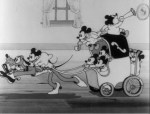 ‘Mickey’s Nightmare’ is not a spooky horror cartoon like ‘The Haunted House‘ or ‘The Gorilla Mystery‘. No, it’s more of a bachelor’s nightmare…
‘Mickey’s Nightmare’ is not a spooky horror cartoon like ‘The Haunted House‘ or ‘The Gorilla Mystery‘. No, it’s more of a bachelor’s nightmare…
The short’s plot harks back all the way to ‘Poor Papa’ (1928), the pilot film for the Oswald the Lucky Rabbit series, Mickey’s predecessor. In ‘Mickey’s Nightmare’ Mickey dreams he finally marries Minnie, and is soon visited by a stork delivering a baby, and another, and another… Until the storks deliver tons of little kids. When he is awake he’s very happy to be still a bachelor.
‘Mickey’s Nightmare’ introduces the little orphan mice, who would replace the little kittens of ‘Mickey’s Orphans‘ (1931) and ‘Mickey’s Revue’ (1932) as a cause of complete destruction. In Mickey’s dream they ruin the house, especially with paint. In order to show Mickey’s horror scenario, the short uses some excellent and complex use of animation cycles featuring lots and lots of little kids.
It’s interesting that the orphan mice first were introduced as Mickey’s children, and only in dream form. In their next cartoon, ‘Giantland‘ (1933), they suddenly materialized into the real world. The orphan mice would stay around until 1936, starring five more cartoons, before returning one final time in ‘Pluto’s Party‘ from 1952.
The little brats also appeared in the Sunday Pages of Floyd Gottfredson’s Mickey Mouse comic, starting on September 18. In Gottfredson’s comics the mice are reduced to two, but no less disastrous. They are introduced as Mrs. Fieldmouse’s children and are apparently Mickey’s nephews. These two would eventually be christened Morty and Ferdie, and reenter the movie screen once in ‘Mickey’s Steamroller‘ (1934).
‘Mickey’s Nightmare’ spawned at least two similar cartoons: first the Warner Bros. cartoon ‘Porky’s Romance‘ (1937), and second, the Donald Duck short ‘Donald’s Diary‘ from 1954.
Watch ‘Mickey’s Nightmare’ yourself and tell me what you think:
This is Mickey Mouse cartoon No. 44
To the previous Mickey Mouse cartoon: Mickey in Arabia
To the next Mickey Mouse cartoon: Trader Mickey
‘Mickey’s Nightmare’ is available on the DVD ‘Walt Disney Treasures: Mickey Mouse in black and white’
Directors: Mannie Davis & John Foster
Release Date: January 13, 1933
Rating: ★★★★½
Review:
 ‘Silvery Moon’ starts with the song ‘Moonlight bay’ and the two young cats from ‘The Wild Goose Chase‘ (1932) in a canoe on a moonlit lake, singing the popular song ‘Moonlight Bay’.
‘Silvery Moon’ starts with the song ‘Moonlight bay’ and the two young cats from ‘The Wild Goose Chase‘ (1932) in a canoe on a moonlit lake, singing the popular song ‘Moonlight Bay’.
Suddenly, the moon invites them over, producing a giant staircase, which takes them into the moon’s mouth. Once the two have arrived on the moon, a fairy opens a gate, revealing a dreamlike candy land, revealing that the moon consists of cake, candy and ice cream, just like the girl had predicted.
In the Cockaigne-like Candyland the two frolic around, and eat all what’s around until they get sick. Then they’re hunted by a bottle of castor oil and a spoon, until they fall off the moon, next to their own canoe.
‘Silvery Moon’ was one of the last Aesop’s Fables, and one of the best. Sure, the designs and animation are still poor (some of the animation is reused from ‘Toy Time‘), and the film’s subject may be a little childish, it’s a surprisingly inspired cartoon, showing wonderful events with a natural charm.
At least, for once the strange floating movements of the Van Beuren characters are in sync with the dreamlike atmosphere, and, a little more far-fetched, with the moon’s reduced gravity. The surreal atmosphere of ‘Silvery Moon’ is further enhanced by scenes that change while the two kittens stay in place.
It’s a pity that ‘Silvery Moon’ is in black-and-white, for its dreamy scenery would make perfect subject for color, which in 1933 still was brand new, anyhow (Disney’s first technicolor cartoon, ‘Flowers and Trees‘ had only been released half a year earlier).
Indeed, the cartoon’s content and atmosphere look forward to several color cartoons of the Hayes code era, most notably the Fleischer cartoon ‘Somewhere in Dreamland‘ (1936), which also features two children visiting a Cockaigne-like candy world. This makes ‘Silvery Moon’ probably the most forward-looking cartoon the Van Beuren studio ever made, and it certainly has aged much better than most of the cartoons the studio produced in the early 1930’s.
Watch ‘Silvery Moon’ yourself and tell me what you think:
‘Silvery Moon’ is available on the DVD ‘Aesop’s Fables – Cartoon Classics from the Van Beuren Studio’
Director: Walter Lantz or Bill Nolan
Release Date: January 18, 1932
Stars: Oswald the Rabbit
Rating: ★★
Review:
 By 1932 Oswald had changed into a cute little boy. And yet, in the opening scene of ‘Grandma’s Pet’ he’s shown reading the fairy tale of Little Red Riding Hood to his three nephews(?).
By 1932 Oswald had changed into a cute little boy. And yet, in the opening scene of ‘Grandma’s Pet’ he’s shown reading the fairy tale of Little Red Riding Hood to his three nephews(?).
Soon Oswald falls asleep himself and he dreams that he’s inside the fairy tale himself. Apart from Oswald’s presence, the cartoon quite faithfully follows the fairy tale until the wolf kidnaps Little Red Riding Hood, and out of nowhere produces a magic wand, which changes the complete scenery several times. In the end, Oswald uses the magic wand to change the wolf into a roast.
‘Grandma’s Pet’ is one of the Lantz films in which Tex Avery is billed as an animator. It may have inspired his own mix-up fairy tale films, like ‘Little Red Walking Hood’ (1937) and ‘The Bear’s Tale‘ (1940). It pales when compared to those latter cartoons, however, suffering from erratic animation and sloppy timing.
Watch ‘Grandma’s Pet’ yourself and tell me what you think:
‘Grandma’s Pet’ is available on the DVD ‘The Woody Woodpecker and Friends Classic Cartoon Collection’
Director: Rudolf Ising
Release Date: September 5, 1931
Stars: Foxy
Rating: ★★★
Review:
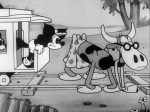 ‘Smile, Darn Ya, Smile!’, the second of the Merrie Melodies, is also the second to feature that short-lived early star of Warner Bros., Foxy.
‘Smile, Darn Ya, Smile!’, the second of the Merrie Melodies, is also the second to feature that short-lived early star of Warner Bros., Foxy.
The film is practically a remake of Oswald’s first cartoon, ‘Trolley Troubles’ (1927), on which Harman and Ising had worked themselves: Foxy rides a trolley, inviting his very, very Minnie Mouse-like girlfriend along. Like in the former Oswald film, the ride ends with Foxy losing control of the trolley, which leads to some spectacular perspective animation. Unlike the earlier film, however, ‘Smile, Darn ya, Smile!’ ends rather cornily, when it’s revealed it was all a dream.
The title song is sung several times during the cartoon, e.g. by four hobos. It was revived more than fifty years later in ‘Who Framed Roger Rabbit‘ (1988), when Eddie Valiant enters Toontown.
Watch ‘Smile, Darn Ya, Smile’ yourself and tell me what you think:
‘Smile, Darn Ya, Smile’ is available on the DVD ‘Looney Tunes Golden Collection Volume Six’
Director: Wilfred Jackson
Release Date: July 28, 1931
Rating: ★★★½
Review:
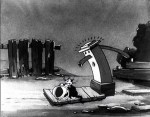 A cat is put out. When he tries to catch a bird, he falls down and gets knocked unconscious by a wind-flower.
A cat is put out. When he tries to catch a bird, he falls down and gets knocked unconscious by a wind-flower.
Enter a nightmarish sequence, in which the cat imagines his lives are fleeing him, and that he’s being attacked by giant birds, hooting owls, bats, giant spiders and hollow trees. Luckily, in the morning it all appears to have been a dream.
‘The Cat’s Out’ is not devoid of dance routines (there are two dance scenes featuring scarecrows and a bat), but it has a surprisingly clear story, unmatched by earlier Silly Symphonies. It is arguably the first Silly Symphony with such a clear story, anticipating the straightforward storytelling of ‘The Ugly Duckling‘ of the end of the same year. This makes the short one of the most interesting Silly Symphonies of 1931.
Watch ‘The Cat’s Out’ yourself and tell me what you think:
This is Silly Symphony No. 20
To the previous Silly Symphony: The Busy Beavers
To the next Silly Symphony: Egyptian Melodies
‘The Cat’s Out’ is available on the DVD ‘Walt Disney Treasures: More Silly Symphonies’
Director: Charles Nichols
Release Date: May 18, 1951
Stars: Mickey Mouse, Pluto, Milton
Rating: ★★★★★
Review:
 In ‘Plutopia’ Mickey and Pluto reach a cabin in the mountains called Utopia.
In ‘Plutopia’ Mickey and Pluto reach a cabin in the mountains called Utopia.
The place turns out to be dog-unfriendly however: Pluto has to stay outside and even worse, has to be muzzled. Frustrated, Pluto falls asleep. He dreams he’s in Plutopia where Milton (one of the cats from ‘Puss-Cafe‘, and here the cabin’s cat) is his willing servant, serving him food every time Pluto bites him in his tail.
The dream sequence is a delight to watch: its backgrounds consists of no more than changing monochromes featuring ‘scribbled’ outlines of doors, stairs e.g. With this sequence Pluto enters the ‘cartoon modern’ era. Unfortunately, it would be his only cartoon featuring such modern designs.
‘Plutopia’ is the last of only three Pluto cartoons featuring Mickey Mouse (the other two being ‘Pluto’s Purchase’ from 1948 and ‘Pueblo Pluto‘ from 1949). Normally cartoons featuring Mickey would appear under his own name. Indeed, after ‘Plutopia’ the Pluto series had only one entry left, but Pluto would return in Mickey’s last four cartoons.
Remarkably, ‘Plutopia’ features animation by two of the greatest animators of Mickey and Pluto in the 1930s: Fred Moore and Norm Ferguson. Both animators had been eclipsed by Disney’s Nine Old Men, and ‘Plutopia’ is one of the last films they worked on before their premature deaths in 1952 and 1957, respectively.
Watch ‘Plutopia’ yourself and tell me what you think:
This is Pluto cartoon No. 42
To the previous Pluto cartoon: Cold Storage
To the next Pluto cartoon: Cold Turkey
Director: Bob Clampett
Release Date: October 5, 1946
Stars: Bugs Bunny, Elmer Fudd
Rating: ★★★★½
Review:
 ‘The Big Snooze’ (a pun on the Bacall-Bogart vehicle ‘The Big Sleep’) opens with Elmer quitting after a short chase routine involving a tree trunk on a cliff.
‘The Big Snooze’ (a pun on the Bacall-Bogart vehicle ‘The Big Sleep’) opens with Elmer quitting after a short chase routine involving a tree trunk on a cliff.
He tears his contract with Warner apart and decides to enter a career of fishing only ‘and no more wabbits!’. When he rests at the riverside, Bugs enters his serene dream to create a nightmare. This involves e.g. nightmare paint, rendering Elmer in Adam’s costume, making a girl out of him, followed by wolves and a great fall, which typically ends the nightmare. At the end Elmer returns to the scene, reassembling the contract and ready for another routine with the tree.
‘The Big Snooze’ is one of those great cartoons that play with their characters as being real stars (others being the Mickey Mouse cartoon ‘Mickey’s Gala Premier’ (1933), the Donald Duck cartoon ‘The Autograph Hound‘ (1939) and ‘You Ought to Be in Pictures’ (1940, starring Porky and Daffy).
The opening scene was taken from Tex Avery’s ‘All This and Rabbit Stew’ (1941), with Elmer replacing the original black caricature. The rest of the film has a disjointed feel, and features weird cuts and odd cinematographic choices. For example, when Elmer tears up the contract, this is shown in five different shots, following each other in rapid succession: 1) a medium shot of Elmer tearing up the contract, 2) a close-up of only his hands tearing, 3) a close-up of the paper snippets flying into the air above Elmer’s head, who’s hardly seen in this shot, 4) a very strange perspective shot of Elmer smashing the contract into the camera, and 5) a close-up of his boots stamping on what remains of the paper.
Another noteworthy scene is when Bugs Bunny is ‘multiplying’: in this scene Elmer is the only traditionally looking character, placed on a black canvas, overrun by rabbits, only drawn in red, yellow and pink outlines and mixing with the green outlines of some plants. This short scene is a startling piece of early cartoon modernism, and looks forward to the work of the UPA studio in the 1950s. On the other hand, the gag in which Bugs pulls away a hole harks all the way back to the Mickey Mouse cartoon ‘The Picnic‘ (1930).
Bugs sings excerpts from three songs in this short: ‘Beautiful Dreamer’, ‘Someone’s Rocking My Dreamboat’ and ‘September in the Rain’.
The Big Snooze’ was to be Bob Clampett’s last cartoon at Warner Bros. He was fired before he could finish it, and the short was completed by Art Davis, who succeeded him as a director. The film’s look and feel is still that of the war era, while contemporary cartoons by Chuck Jones and Friz Freleng show the studio was heading into other directions, with milder humor and more sophisticated designs. In contrast, in ‘The Big Snooze’ Clampett’s animation style is extremely flexible, as usual for him, and his backgrounds are as vague as ever.
‘The Big Snooze’ is a hilarious cartoon that marks the end of an era, where the wildest and the zaniest gags were possible. Only Tex Avery at MGM would continue the extreme style. Bob Clampett left Warner Bros. in May 1945 to join the Screen Gems studio. He was succeeded by Art Davis, who would direct some great cartoons until his unit was closed down in 1949.
In the years following Clampett’s leave, his zany style was continued for a while by his master animator Robert McKimson, who had been promoted to director only a few months earlier. However, McKimson soon toned down both animation and humor, and he would never achieve the same level of originality as Bob Clampett did during his Warner Bros. days.
Watch ‘The Big Snooze’ yourself and tell me what you think:
https://www.dailymotion.com/video/x6n3yac
This is Bugs Bunny cartoon No. 40
To the previous Bugs Bunny cartoon: Racketeer Rabbit
To the next Bugs Bunny cartoon: Rhapsody Rabbit
‘The Big Snooze’ is available on the DVD-set ‘Looney Tunes Golden Collection Volume Two’
Director: unknown
Release Date: November 1, 1924
Stars: Virginia Davis (Alice)
Rating: ★★★½
Review:
 Alice is at school singing out of tune and blowing a balloon that contains ink. When it explodes in the teacher’s face, Alice is cornered. There she falls asleep.
Alice is at school singing out of tune and blowing a balloon that contains ink. When it explodes in the teacher’s face, Alice is cornered. There she falls asleep.
Alice dreams she’s making music with a cat, a dog and a donkey, until they are being attacked by a evil horned teacher and three anthropomorphized schoolbooks called ‘reading’, ‘writing’ and ‘arithmetic’. The cat invents a canon to shoot pepper with. The first shot is successful, but the second one explodes in their faces, so Alice and the gang are sneezing their heads off. At that point Alice awakes.
‘Alice Gets in Dutch’ is a rather unremarkable entry in the Alice Comedies series. None of the animation in this short is particularly noteworthy, although the animation of the cat thinking up an invention looks quite good. This cat character would eventually evolve into Alice’s main sidekick, the very Felix the Cat-like Julius. The technique of combining live action and drawings suffers in this short; at some scenes Alice is rendered so light, she’s almost invisible.
Watch ‘Alice Gets In Dutch’ yourself and tell me what you think:
‘Alice Gets In Dutch’ is available on the DVD ‘Walt Disney Treasures: Disney Rarities’


